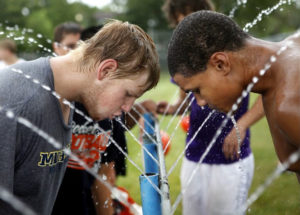High School Heat Illness – Know The Risks
According to the CDC, heat illness during practice or competition is the leading cause of death among U.S. high school athletes. Summer’s high temperatures put high school athletes at increased risk for heat illness. There are several types of heat illness ranging in severity and although heat illness can be fatal, death is preventable if quickly recognized and properly treated.
When does heat related illness occur?
When the body is unable to adequately preserve a constant internal temperature due to both intrinsic and environmental stressors. It encompasses a wide range of issues fr
om simple heat edema and heat rash to the life threatening condition of heat stroke.
Key Statistics
- Exertional heat illnesses are largely preventable when appropriate prevention strategies are implemented. These strategies include heat acclimatization,
 hydration, modifying exercise based on environmental conditions, etc.
hydration, modifying exercise based on environmental conditions, etc. - Exertional heat stroke is one of the three leading causes of sudden death in sport. The period of 2005 to 2009 had more heat stroke deaths than any other five year period in the 35 years prior. There were 18 deaths from 2005 to 2009; from 2010 to 2014 (still being tracked) there are now an estimated 20 to 22 deaths.
- Death from exertional heat stroke is 100 percent preventable when proper recognition and treatment protocols are implemented.
What are the different types of Heat Related Illnesses?
As mentioned Heat Related Illnesses span a wide spectrum of problems and severity. It is also important to note that this spectrum is not necessarily a continual progression. Heat Related Illnesses include heat edema/rash, heat cramps, heat syncope, heat exhaustion, and finally heat stroke.
Executive Summary of National Athletic Trainers’ Association Position Statement on Exertional Heat Illnesses
Prevent of Heat Illness
- A pre-season heat acclimatization policy should be implemented to allow athletes to be acclimatized to the heat gradually over a period of 7 to 14 days. This is optimal for full heat acclimatization.
- Plan rest breaks and modify the work-to-rest ratio to match environmental conditions and the intensity of the activity.
- When environmental conditions warrant, ensure that a cold water immersion tub and ice towels are available to quickly manage an athlete with a suspected heat illness.
Recognition of Exertional Heat Illnesses
- The two main diagnostic criteria for exertional heat stroke are profound central nervous system (CNS) dysfunction and a core body temperature above 105°F.
- Rectal temperature is the only method of obtaining an immediate and accurate measurement of core body temperature in an exercising individual.
Treatment of Exertional Heat Illnesses
- The goal for any exertional heat stroke victim is to lower core body temperature to less than 102.5°F within 30 minutes of collapse.
- Cold water immersion is the most effective way to treat a patient with exertional heat stroke. The water should be 35-59°F and continuously stirred to maximize cooling.
- An athlete suffering from exertional heat stroke should always be cooled first (via cold water immersion) before being transported by EMS to an emergency facility.
- An athlete recovering from exertional heat stroke should be closely monitored by a physician or athletic trainer and return to gradual activity.
Pre-season heat acclimatization protocol
- Days 1-2: Single three hour practice OR single two hour practice and single one hour field session; only helmets may be worn
- Days 3-4: Single three hour practice OR single two hour practice and single one hour field session; only helmets and shoulder pads may be worn
- Day 5: Single three hour practice OR single two hour practice and single one hour field session; full equipment may be worn
- Days 1-5: Equipment guidelines for preseason participation only impact days 1-5 of the acclimatization period
Other Heat Illness articles:
